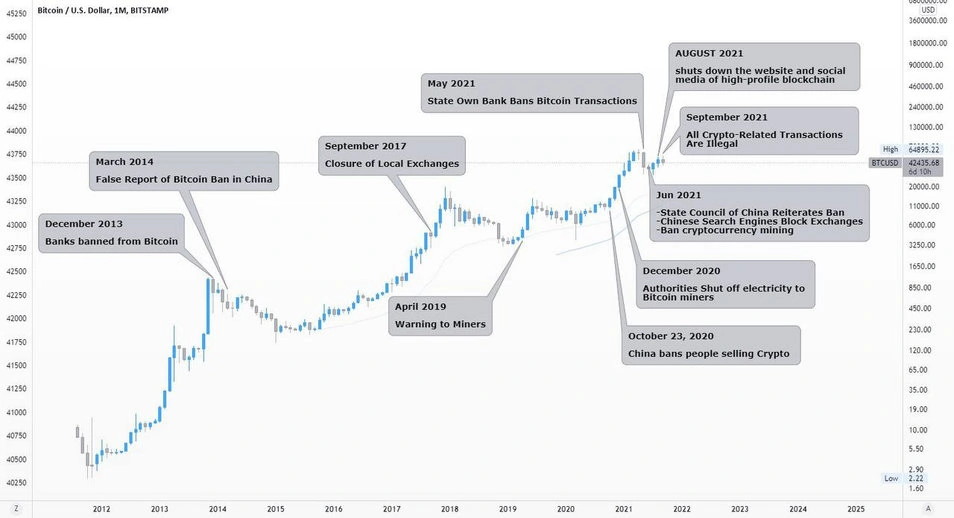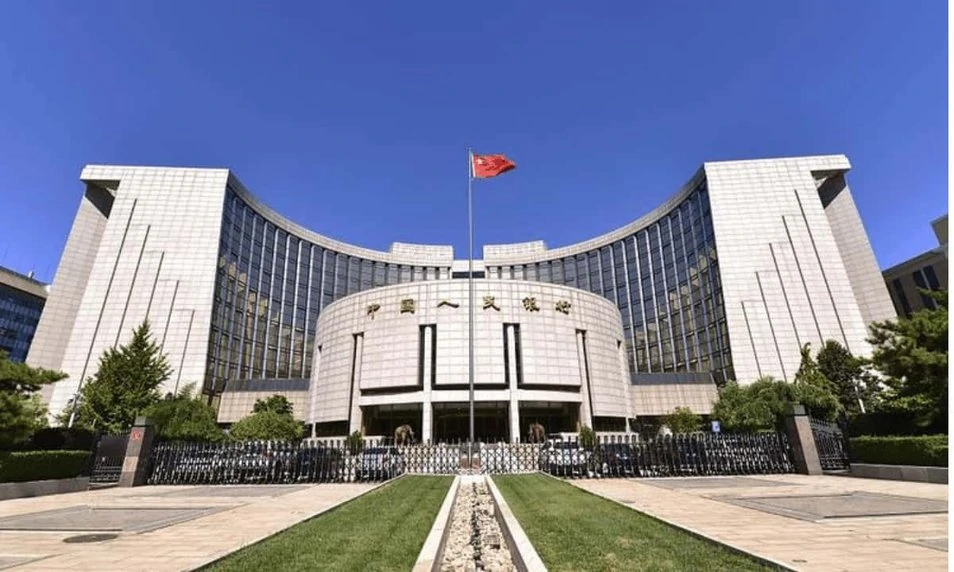In the first year of bitcoin’s existence, the Chinese government attacked the main cryptocurrency, hammering it with ban after ban while citing countless risks associated with it.
In over a decade, the Republic of China has also managed to increase its FUD (short for fear, uncertainty, and doubt) in the industry, and each time, crypto had seen a massive hit. Just last week, the price of bitcoin fell more than 5% in a matter of hours, due to another regulatory reiteration by Chinese authorities to ban cryptocurrencies.
Before we dive into the long history of China FUD, there is good and bad news to this story. The bad news is that this type of Chinese FUD is likely to continue, at least for the next several years. However, the good news is that the effect on the price of Bitcoin seems to be decreasing over time, as BTC is becoming more and more resistant.
China FUD Vs. Bitcoin
With the endless bans and unnecessary repetitive threats, you would think this is a well-coordinated effort to bring the price of bitcoin down. But that might be a story for another day.
For now, let’s walk down memory lane and see all the times China has raised FUD levels in the crypto market through its endless hostile stance and vows to end crypto activities and how the industry continues to triumph.

2009 – Ban on digital currencies
In June 2009, just months after the launch of bitcoin, the Chinese Ministry of Commerce and the Ministry of Culture banned the use of digital currencies to make payments for real-world goods and services.
The move, however, was not explicitly targeted at bitcoin, instead, it was to curtail several video-game currencies that were supposedly devaluing the yuan.
2013 – China erupts after Bitcoin’s first big bull run
Four years later, in December 2013, the world’s most populous nation launched its first direct attack on the use of bitcoin, calling it a “currency with no real value.”
The People’s Bank of China (PBoC) and the IT Ministry published a note mandating every Chinese financial institution to stop processing bitcoin transactions.
The effect of this advice was immediate, forcing the price of bitcoin, which had just crossed the $ 1,000 mark, to drop massively – the first price impact of many to follow.

2014 – The Bear Market Driven by China FUD
After bouncing back from the 2013 China FUD, the crypto industry was once again struck with another devastating report that the “PBoC has placed an outright ban on Bitcoin transactions.”
While this news, published in March 2014 by Weibo, turned out to be false, its effect on the market was catastrophic. Thousands of traders and investors liquidated their positions, and bitcoin’s price took a nosedive. BTC, which was trading above the $ 1,000 mark in late 2013, was heading towards $ 400 three months later.
2017 – Exchanges Forced to Leave China
2017 will always remain a memorable year in the history of crypto. This was the first time bitcoin hit $ 20,000 in December, yet it had come up with more FUD from the Chinese government than in previous years.
In mid-2017, the PBoC dropped two regulatory bombs in the same month. The first ban was on initial coin offerings (ICOs), which were all the rage at the time. The second was targeted at cryptocurrency exchanges.
Authorities insisted that every ongoing ICO in the country be immediately halted, citing that these were illegal forms of public funding and were not authorized by Chinese financial regulators.
By mid-September, the PBoC hit the crypto market with the notice of yet another ban. Every cryptocurrency exchange operating in the country has been appointed to discontinue its services by the end of September 2017, citing the risks of their use to facilitate criminal activities such as drug trafficking, money laundering and smuggling.
Several top crypto exchanges, including Binance – which was operating from China back then, had no other option but to relocate and crypto traders across the country had to move their trading activities to overseas platforms via VPNs.
The prices of major cryptocurrencies have suffered. But as always, the market recovered in three months, and it even proved to be a breaking point for crypto around the world as BTC hit its all-time high (ATH) of $ 20,000 in December. 2017.

2018 – Targeting Mining
In early 2018, Bitcoin suffered one of its biggest price crashes in history. Shortly after finishing 2017 with highs of $ 20,000, the value of the primary digital asset fell more than 65% against the US dollar around February of the same year.
While there was no solid reason for the decline, several reports suggested that the plunge was closely tied to the Chinese New Year and rumors of a new crackdown on crypto mining.
In August 2018, China would have Posted another document officially banning all crypto activity in the region. The paper focused on communication channels as it prohibited commercial venues like WeChat accounts, media outlets, and others from hosting any crypto-related events or activities.
2019 – Bitcoin Mining Ban Confirmed
Rumors of a massive crackdown on bitcoin mining were confirmed in April 2019, when a draft warning from the country’s National Development and Reform Commission (NDRC) noted that the regulator was planning to eliminate these activities in China.
The draft argued that bitcoin mining did not adhere to relevant laws and regulations set in place and polluted the environment. The price of BTC, once again, has dropped significantly.
2020 – Power plants ordered to cut off electricity to miners
With the outset of the COVID-19 Pandemic, several Chinese miners liquidated their crypto holdings, resulting in the massive bloodbath in March, which saw bitcoin and almost all altcoins losing more than 50% of their value.
Despite the global pandemic, in May 2020, local government authorities in the Chinese province of Sichuan sought to ban cryptocurrency mining operations in the region.
In October, the market was struck again by a ban on crypto trading. Violators were threatened with fines equivalent to five times the value of their crypto funds.
In December, power stations in the Yunnan province, where many of the largest crypto mining hubs in China were located, received mandates from the local authorities to stop providing power to miners in the city. This caused the bitcoin hash rate to drop sharply.
However, bitcoin was able to break the $20,000 mark and end 2020 with a new ATH of over $30,000. The hashrate also recovered quite quickly.
2021 – Miners leave China: crypto is ‘illegal’
2021 started off for bitcoin and the crypto market at large. After finishing the previous year with a high of 30,000, BTC continued to break new records until it peaked at around $ 65,000 in mid-April.
However, things quickly became dark for crypto traders as the Chinese government embarked on a nationwide campaign against crypto mining and trading. He reiterated for the 20th time his warnings to citizens about the risks associated with investing in such “speculative” assets.
Even though every financial service provider and payment gateway in the country has already been prohibited from working with crypto entities since 2013, the news resurfaced in May 2021 and sent the crypto market crashing down the hill. Bitcoin has lost almost half of its value in a matter of weeks.
Within the last four months, China has intensified its fight against crypto activities like never before. In June, officials reiterated the ban on bitcoin mining (again) and led a massive crackdown on bitcoin mining facilities, forcing miners to shut down their machines.
The clampdown on such operations not only affected several key on-chain metrics and caused prices to drop but also prompted the still-ongoing Great China Mining Migration, as miners in the region started moving to other crypto-friendly locations.
In July, another report revealed that the PBoC had shut down a tech company that allegedly provided software services to local cryptocurrency entities. Bitcoin’s price immediately fell as soon as the news broke.
In August, China took on crypto-influencers and the government shut down the website and social media of the country’s leading blockchain hub.
On September 24, the market took another hit as the PBoC supposedly declared that all crypto-related transactions in the country are illegal. Even though the new September 3 date didn’t stop the price of bitcoin from shredding $ 4,000 in a matter of hours, causing massive sell-offs.
Verdict: Bitcoin always triumphs
For the past years, the Chinese authorities have often tried to bully bitcoin and force it out of existence, but all its efforts – so far – have always proved a failure. The crypto industry continues to thrive as the market generally recovers from all the blows it receives from the giant Asian nation.
Bitcoin has retained its position as the largest cryptocurrency, with an influx of large institutional investors fueling its adoption rates.
Judging by the patterns of previous cases caused by the Chinese government, bitcoin often performs a massive bull run within months of being hit by the same old Chinese regulatory song.
Will China’s latest attack spur bitcoin to another ATH? Only time will tell.


















